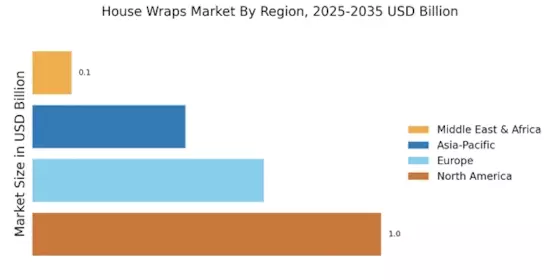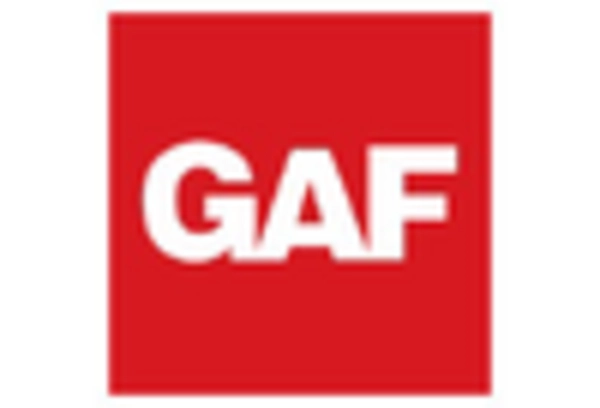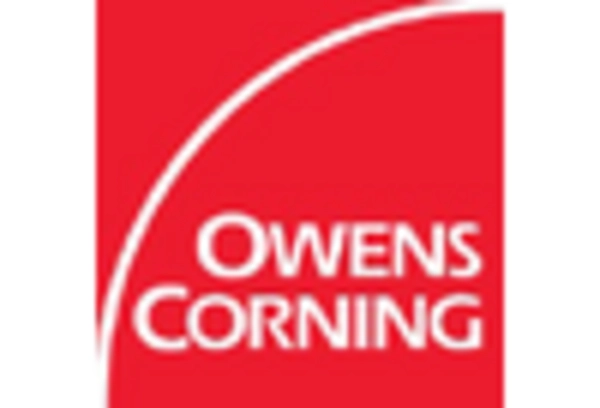Rising Construction Activities
The House Wraps Market is experiencing a notable surge due to increasing construction activities across various sectors. As urbanization accelerates, the demand for residential and commercial buildings rises, leading to a greater need for effective moisture management solutions. In 2025, the construction sector is projected to grow at a compound annual growth rate of approximately 5.5%, which directly influences the consumption of house wraps. These materials play a crucial role in enhancing energy efficiency and protecting structures from environmental elements. Consequently, builders and contractors are increasingly opting for house wraps to ensure durability and compliance with building codes. This trend indicates a robust market potential for house wraps, as they become integral to modern construction practices.
Technological Innovations in Materials
The House Wraps Market is benefiting from ongoing technological innovations that enhance the performance and functionality of house wraps. Manufacturers are increasingly developing advanced materials that offer superior moisture resistance, breathability, and durability. Innovations such as breathable membranes and self-adhering wraps are gaining traction, providing builders with more effective solutions for moisture management. In 2025, it is anticipated that the market for technologically advanced house wraps will grow by approximately 7%, as builders seek to leverage these innovations to improve building performance. This trend not only enhances the appeal of house wraps but also positions them as essential components in modern construction practices.
Regulatory Standards and Building Codes
The House Wraps Market is significantly influenced by evolving regulatory standards and building codes that emphasize energy efficiency and moisture control. Governments and regulatory bodies are increasingly mandating the use of house wraps in new constructions to enhance thermal performance and reduce energy consumption. For instance, the implementation of stricter energy codes in various regions has led to a heightened awareness of the benefits of house wraps. In 2025, it is estimated that over 60% of new residential buildings will incorporate advanced house wrap technologies to meet these regulations. This shift not only drives demand but also encourages manufacturers to innovate and improve their product offerings, thereby expanding the market landscape.
Increased Awareness of Energy Efficiency
The House Wraps Market is witnessing a growing awareness of energy efficiency among consumers and builders alike. As energy costs continue to rise, there is a heightened focus on reducing energy consumption in buildings. House wraps serve as a vital component in achieving better insulation and minimizing air leaks, which can lead to significant energy savings. In 2025, it is projected that energy-efficient building materials, including house wraps, will account for nearly 40% of the total construction materials market. This trend reflects a shift in consumer preferences towards sustainable building practices, thereby driving the demand for house wraps that contribute to lower energy bills and enhanced comfort in living spaces.
Growing Demand for Sustainable Building Solutions
The House Wraps Market is experiencing a shift towards sustainable building solutions, driven by both consumer preferences and environmental considerations. As awareness of climate change and environmental impact increases, builders and homeowners are seeking materials that contribute to sustainability. House wraps made from recycled or eco-friendly materials are gaining popularity, aligning with the broader trend of green building practices. In 2025, it is estimated that the market for sustainable building materials, including house wraps, will reach a valuation of over 15 billion dollars. This growing demand not only supports the expansion of the house wraps market but also encourages manufacturers to adopt sustainable practices in their production processes.


















Leave a Comment